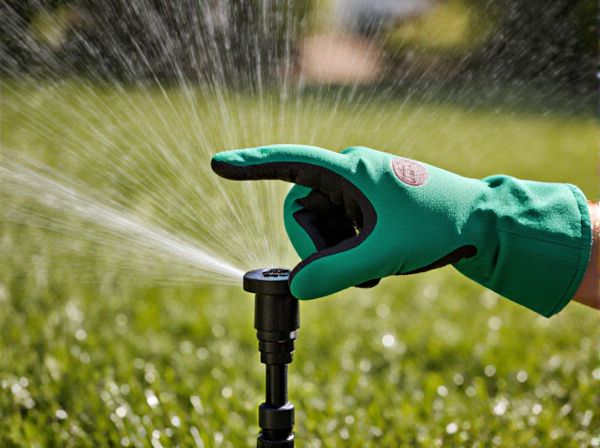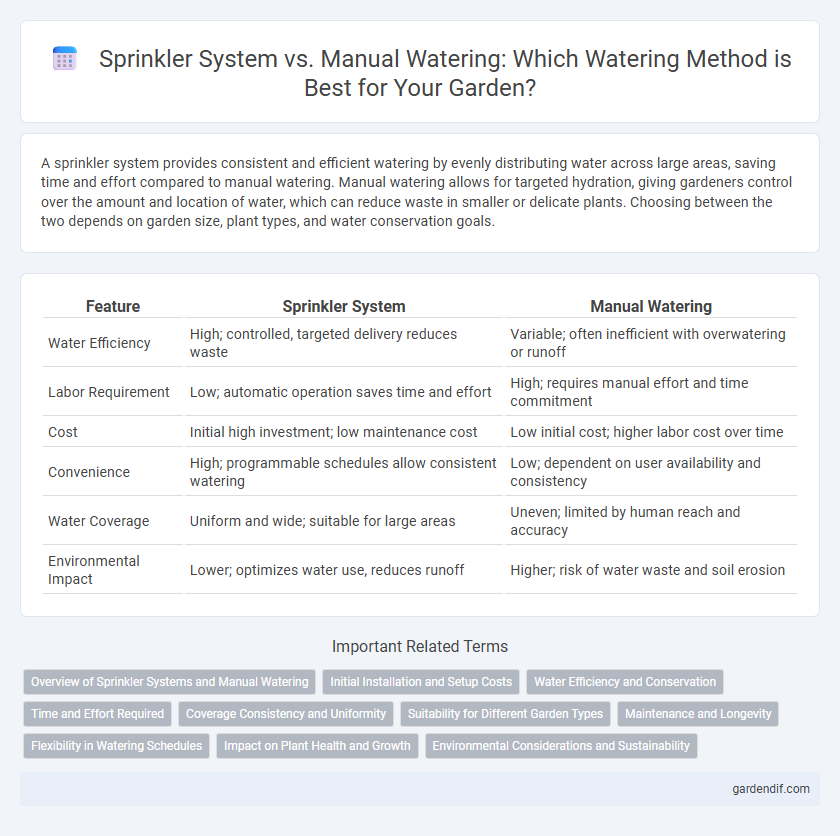
Sprinkler system vs Manual watering Illustration
A sprinkler system provides consistent and efficient watering by evenly distributing water across large areas, saving time and effort compared to manual watering. Manual watering allows for targeted hydration, giving gardeners control over the amount and location of water, which can reduce waste in smaller or delicate plants. Choosing between the two depends on garden size, plant types, and water conservation goals.
Table of Comparison
| Feature | Sprinkler System | Manual Watering |
|---|---|---|
| Water Efficiency | High; controlled, targeted delivery reduces waste | Variable; often inefficient with overwatering or runoff |
| Labor Requirement | Low; automatic operation saves time and effort | High; requires manual effort and time commitment |
| Cost | Initial high investment; low maintenance cost | Low initial cost; higher labor cost over time |
| Convenience | High; programmable schedules allow consistent watering | Low; dependent on user availability and consistency |
| Water Coverage | Uniform and wide; suitable for large areas | Uneven; limited by human reach and accuracy |
| Environmental Impact | Lower; optimizes water use, reduces runoff | Higher; risk of water waste and soil erosion |
Overview of Sprinkler Systems and Manual Watering
Sprinkler systems provide automated, consistent watering by distributing water evenly across lawns or gardens through fixed or oscillating spray heads, allowing for precise control over water usage and schedules. Manual watering involves using hoses or watering cans, which can lead to uneven coverage and requires more time and attention to avoid under- or over-watering. Sprinkler systems enhance efficiency by reducing water waste and promoting healthier plant growth through uniform moisture distribution compared to manual watering methods.
Initial Installation and Setup Costs
Sprinkler systems require a higher initial installation and setup cost due to the need for piping, timers, and professional labor, typically ranging from $1,500 to $3,000 for residential setups. Manual watering involves minimal upfront expenses, mainly limited to purchasing hoses and watering cans, often under $100. Investing in a sprinkler system can reduce long-term labor costs despite the higher initial expenditure.
Water Efficiency and Conservation
Sprinkler systems optimize water distribution by delivering precise amounts directly to plants, reducing runoff and evaporation compared to manual watering methods that often lead to overwatering and water waste. Automated timers and moisture sensors in sprinkler systems enhance water efficiency by adjusting watering schedules based on weather conditions and soil moisture levels. Manual watering frequently results in inconsistent application, whereas sprinkler systems support conservation efforts through controlled, repeatable irrigation that maximizes water use effectiveness in gardens and landscapes.
Time and Effort Required
Sprinkler systems significantly reduce the time and effort required for watering by automating the process and covering large areas efficiently. Manual watering demands consistent physical involvement and more time, especially in extensive gardens or lawns. Automation through sprinklers ensures precise water distribution while freeing up valuable time otherwise spent on routine watering tasks.
Coverage Consistency and Uniformity
Sprinkler systems provide consistent and uniform water coverage across lawns and garden beds, ensuring each area receives adequate moisture without overwatering or dry spots. Manual watering often results in uneven coverage due to human error and variable water pressure, leading to patches of under- or over-watered plants. Automated sprinklers equipped with adjustable nozzles and timers optimize water distribution, promoting healthier plant growth and water conservation.
Suitability for Different Garden Types
Sprinkler systems are ideal for large, evenly landscaped gardens, offering uniform water distribution and time efficiency. Manual watering suits small or irregularly shaped gardens, allowing targeted hydration for delicate plants and conserving water in intricate layouts. Choosing the right method depends on garden size, plant types, and water management preferences.
Maintenance and Longevity
Sprinkler systems require regular inspection and occasional part replacements, such as nozzles and timers, but their automated operation reduces the risk of human error that can cause wear and tear. Manual watering demands consistent attention to avoid overwatering or underwatering, which can stress plants and degrade soil quality over time. Properly maintained sprinkler systems typically offer greater longevity and consistent performance compared to manual watering methods.
Flexibility in Watering Schedules
Sprinkler systems offer high flexibility in watering schedules through programmable timers that enable precise control over watering frequency and duration. Manual watering requires hands-on effort and lacks consistency, making it challenging to maintain optimal soil moisture for plants. Automated sprinklers adapt easily to changing weather conditions and plant needs, improving water efficiency and promoting healthier landscapes.
Impact on Plant Health and Growth
Sprinkler systems deliver consistent and even water coverage, promoting uniform plant hydration and reducing stress, which enhances overall plant health and growth. Manual watering can lead to uneven moisture distribution, increasing the risk of overwatering or underwatering, which may cause root damage or slower growth. Automated sprinkler systems also optimize watering schedules based on plant needs and soil conditions, ensuring better resource efficiency and healthier plants.
Environmental Considerations and Sustainability
Sprinkler systems optimize water distribution efficiency by delivering precise amounts to targeted areas, reducing water waste compared to manual watering methods that often lead to overwatering or runoff. Automated timers and moisture sensors integrated into sprinkler systems enhance sustainability by conserving water and supporting healthier plant growth. Manual watering requires more time and effort, increasing the likelihood of inconsistent irrigation and higher water consumption, which negatively impacts environmental conservation efforts.
Sprinkler system vs Manual watering Infographic

 gardendif.com
gardendif.com